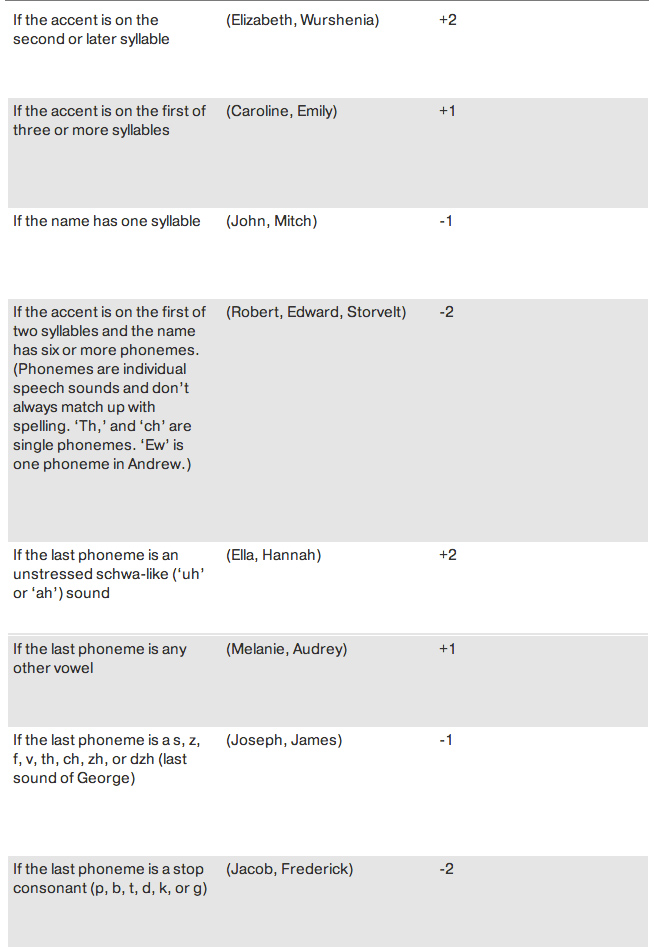Why have baby-names become increasingly female-sounding?
Since 1950, both boys' and girls' names have been taking on more feminine characteristics


There are girls' names, and there are boys' names. Yes, there are also some names, like Pat, Chris, and Casey, that can go either way, and yes, there are girls named James, and boys named Sue, but overwhelmingly, names indicate gender. We assume Elizabeth is a girl, and Thomas is a boy. How do we know? Those name/gender pairings match our experience. We've learned them that way. This is not necessarily interesting. What is interesting is that we also make assumptions about names we've never heard before. Do you think Sturvelt is a girl or a boy? What about Wurshenia?
Going by sound alone, a name can seem male or female, but why? What aspects of the sound are we noticing in making this distinction? Syllable structure, individual sounds, and their position within the word all play a role. But the interaction between these cues can be complicated. Fortunately, there is a way to boil it all down to a single number. In a 1995 paper, Herbert Barry and Aylene Harper described a method for calculating what they call the "phonetic gender score" of a name.
Here's how to get your phonetic gender score:
The Week
Escape your echo chamber. Get the facts behind the news, plus analysis from multiple perspectives.

Sign up for The Week's Free Newsletters
From our morning news briefing to a weekly Good News Newsletter, get the best of The Week delivered directly to your inbox.
From our morning news briefing to a weekly Good News Newsletter, get the best of The Week delivered directly to your inbox.

It's important to keep in mind that the scoring is not based on spelling, but sound. "Joseph" ends in an 'f' phoneme. "Audrey" ends in an 'ee' vowel. Many common names will get a neutral score of 0, especially two syllable names with stress on the first syllable that end in n, m, l, or r (Jaden, Liam, Taylor, Helen).
As you can probably tell from the examples given, the positive values associate with aspects more common in female names, and negative values with aspects of male names. A very female name (e.g., Sophia) scores a 4. A very male name (e.g., Edward) scores a -4. But names of either gender can have any of these features. Anthony gets a +1 for having three syllables and a +1 for ending in a vowel. Faith gets a -1 for being one syllable and a -1 for ending with a th. According to this scoring system, Scarlett has a very male profile and Jeremiah has a very female profile. The phonetic gender score may not make the right prediction about every name, but it captures a general pattern that we seem to be psychologically attuned to. We've absorbed the pattern without realizing it, and we use it to make judgments about unfamiliar names.
When Barry and Harper used their phonetic gender score to compare groups of names from 1960 and 1990, they found that the average score for the most popular baby names had increased over time for both girls and boys. In other words, names for both sexes had gotten more female in their sound characteristics. I was curious about whether this trend had continued since 1990 and how it looked in a larger time frame. So I ran some numbers.
I calculated the phonetic gender score for the top 100 boy and top 100 girl names in the United States for the years 1880 (the first year of record-keeping), 1950, 1990, and 2013. As you can see from the chart, boys' and girls' names in every year score significantly differently from each other, meaning that the phonetic gender score is a reliable indicator of name gender. The chart also shows little change in scores for the first 70 years of recordkeeping, with a slight increase in feminine characteristics for girls' names and for masculine characteristics for boys' names. After 1950, both girls' and boys' names begin a marked rise in score and the rise continues after 1990. Both boys' and girls' names are taking on more feminine phonetic characteristics.
A free daily email with the biggest news stories of the day – and the best features from TheWeek.com
What accounts for the change? Looking at the tallies for each criterion of the phonetic gender score, a few trends emerge. For both boys and girls, there has been a move away from one-syllable names. (Some that were popular in 1950 that are no longer on the list: Bruce, Earl, Roy, Carl, Joyce, Joan, Gail, Rose.) This makes the average score for both rise. Another factor is a recent trend in biblical names for boys like Elijah, Isiah, Jeremiah, Josiah, and Joshua. These multisyllabic names with unstressed first syllables and schwa-like vowels on the end have a feminine profile according to the score criteria. In 1880, only one boys' name in the top 100 ended in schwa (Ira). In 1950, none did. This year there are six, including the number one name on the list, Noah.
Another change is a drop in the number of boys' names that end in stop consonants and consonant clusters. Names that were once popular — like Harold, Howard, Leonard, Clifford, and Albert — have gone out of style. This year Robert is the only name of that type to make the top 100 (and the only name to score a -4)
For girls' names, besides the drop in one-syllable names, an increase in vowel endings for the top hundred names seems to be the primary cause of the overall score rise. Half the girls' names ended in a vowel sound in 1950. For 2013, 68 of them do.
The general pattern of increasing phonetic gender score holds whether you look at the top 100, 50, 20, or even just the top 10 names, but the chart for the top 10 reveals an interesting possible explanation for what might be going on here.
The top 10 names will account for a large percentage of the names given in any particular year (though the top 10 accounts for less of a percentage than it used to). This chart shows a sharp increase in score for boys' names between 1950 and 1990. After that the change levels off somewhat. Girls' names then seem to respond to that change with a change of their own, one that enhances the difference between the name groups. In simple terms, boys' names became more like girls' names so people started making girls' names girlier. Naming practices change over the years, but there is a general tendency to maintain gender distinctions. If the names get too similar to each other, adjustments will be made toward gender polarization.
There is nothing intrinsically masculine or feminine about any particular phonetic characteristic. We experience sound properties as masculine or feminine because they are implicitly represented that way in the names we learn. Boys' names did not actually become more feminine. Boys' names changed. Howard/Albert/Clifford type names went out of style, making the characteristics they exhibited (stop consonant endings, more than six phonemes) a less reliable cue for maleness. Girls' names changed in order to maintain the gender distinction.
The overarching drive in naming practices over time seems not to be toward giving names pre-determined masculine or feminine properties, but toward keeping them different.
Arika Okrent is editor-at-large at TheWeek.com and a frequent contributor to Mental Floss. She is the author of In the Land of Invented Languages, a history of the attempt to build a better language. She holds a doctorate in linguistics and a first-level certification in Klingon. Follow her on Twitter.
-
 Political cartoons for January 17
Political cartoons for January 17Cartoons Saturday’s political cartoons include hard hats, compliance, and more
-
 Ultimate pasta alla Norma
Ultimate pasta alla NormaThe Week Recommends White miso and eggplant enrich the flavour of this classic pasta dish
-
 Death in Minneapolis: a shooting dividing the US
Death in Minneapolis: a shooting dividing the USIn the Spotlight Federal response to Renee Good’s shooting suggest priority is ‘vilifying Trump’s perceived enemies rather than informing the public’
